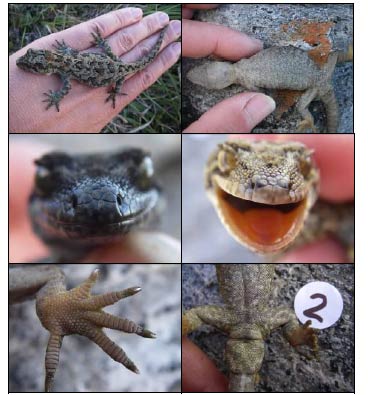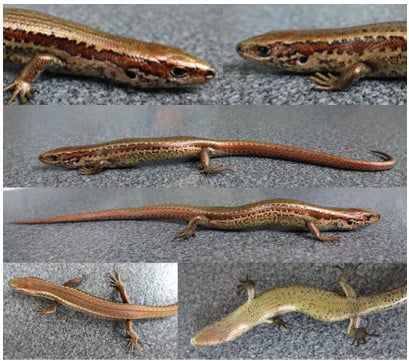Important features used to identify lizards
Experts use a variety of features to identify lizards, including scale numbers, pattern, colour, and scale arrangement. Because subtle differences are important, try and take high-quality photos to show these features.

Figure 1: Gecko features (as shown on a Cascades gecko)
Image: Marieke Lettink, Fauna Finders ©
Gecko features
Figure 1 shows the important features for identifying geckos, which are:
- dorsal and ventral patterning and colouration (top row)
- arrangement of the nostrils in relation to the large rostral scale at the tip of the nose (middle row, left)
- colouration of the mouth lining and tongue (middle row, right)
- underside of hind foot showing the lamellae (broad, transverse scales) on the fourth or longest toe (bottom row, left)
- vent region of an adult male (bottom row, right).
Note: Photos in Figure 1 were taken using the macro function of a Pentax WPi digital camera. Photos alone could not identify the species in this case (as for many other gecko surveys). Genetic analysis of biopsy samples (eg tail tips), had to be done.
Skink features

Figure 2: Skink features as shown on a kapitia skink
Image: DOC
Figure 2 shows the important features for identifying skinks, which are:
- lateral patterning and scale counts (top three rows)
- dorsal and ventral pattern and scale counts (bottom row).
How to take photos for lizard identification
- Take photos that are in focus and in high resolution.
- Take photos that show the important features for identifying skinks and geckos.
- Take close-up photos to show the detail of scales and scale patterns.
- If possible, take the photo with natural diffused light.
- Take multiple photos if there is any doubt.
Get help identifying lizards
The following sites can help you identify lizards:
Report a sighting
If you have made any observation of a lizard or frog, fill out an Amphibian and Reptile Distribution Scheme Card (ARDS card) and report your sighting.
If you are making a lizard observation with photos, note:
- the number of photographs taken, and their reference numbers as given by the digital camera
- the weather conditions, such as ambient (shade air) temperatures, relative humidity, overnight minimum temperature, day-time maximum temperature, precipitation, cloud cover and wind direction and strength
- details about the lizard/s including, where possible, snout-vent length, mass in grams, sex of mature individuals and the reproductive status of females (pregnant/gravid or not gravid).